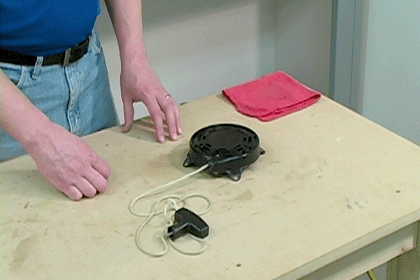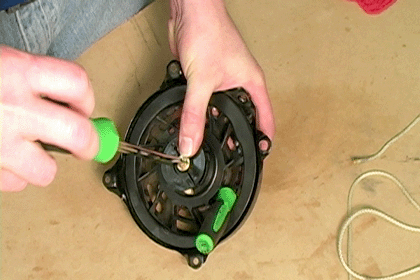Tools & Materials
- Standard flathead or phillips screwdriver (depending on your recoil starter)
- Optional small screwdriver
Safety Guidelines

In most cases, the recoil starter fails because the spring slides out of place, causing it to lose tension. Luckily, when this happens, you can fix your recoil starter in about 20 minutes.
Your recoil starter may also fail because the pulley or recoil housing has worn and the spring no longer sits in the housing correctly. We used a Briggs and Stratton starter for this repair, but most starters will require the same steps. Visit our Briggs and Stratton parts page to find the right parts for your Briggs and Stratton starter.
[Back to Top]
Repair the Recoil Starter
The starter repaired in this video comes off a Briggs and Stratton engine. Most recoil housings will be similar to this model.
Caution: Once you put tension on the pulley and spring, you will want to hold the housing securely. A small tab on the pulley can cut your hand if you accidentally let go of the recoil starter when it is tensioned.

1. Remove the recoil housing cap
Unscrew the cap that holds the pulley to the recoil starter housing.

If your spring has slid out of the slots in the housing, then you can continue with the repair. If the housing, pulley or spring have failed, then you will need the proper replacement parts before continuing.
2. Untie the rope
Untie the knot in the rope and slide it out of the housing.

3. Replace parts (if needed)
Swap out the pulley, housing or spring if the parts need replacing.
4. Re-tension the spring
Now it's time to re-tension the spring. Think about how you want the rope to return into the housing. You will need to wind the pulley in the opposite direction.

With the pulley in the recoil housing, turn it about six times. Once you have tensioned the spring, use a small screwdriver to keep the pulley from spinning.

5. Attach the cap
Reattach the cap that holds the pulley to the recoil housing. While the cap will secure the assembly, it will not prevent the pulley from spinning, so keep a good grip on the pulley.

6. Reinstall the rope
Line up the holes on the pulley and the recoil housing and thread the rope through them both.

Tie a single overhand knot in the end of the rope. If you're worried about the knot untying itself, add a coating of thin super glue to keep it secure.

Pull the starter cord tight in the housing and ensure the knot won't interfere with the pulley's ability to rotate in the housing.

7. Coil the cord
Hold the recoil starter firmly--it is still under tension--and remove the screwdriver.

Pull the starter cord tight and then let go of the pulley. Control the rope speed as the pulley winds the rope back into the starter.

[Back to Top]
Conclusion You can easily repair a broken small engine recoil starter yourself. In many cases you can remedy a broken recoil starter with a screwdriver, the stock parts and about 20 minutes of time.
Since eReplacementParts.com stocks a wide assortment of small engine parts. You can find the recoil housing, spring or pulley you need for those times when the repair requires more than just re-tensioning the spring. Just use our search feature to find the right parts for your lawn equipment and power tools. [Back to Top]
What we're about.



















































